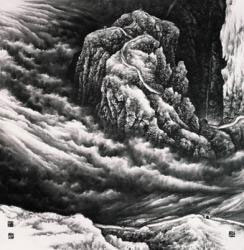In traditional Chinese painting black ink is of unique importance. It has a 'dark', 'light', 'dry', 'wet' or 'black' quality according to the way in which it is applied to the page. These shades of black can be used as if they were true colors. Black is, in fact, normally favored over colors by Chinese artists. They use a range of techniques to make distinctive use of the subtle shades possible with a single tint; the more ink that is added to the brush, the darker the brush stroke, and if the brush is used to absorb more water, then the effect is light, or 'wet'.
While Chinese ink and wash paintings show evidence of the development of themes, traditionally there is greater emphasis on technique since the properties of the brush and ink are considered to be the substance of art. Artists have to practice constantly in order to reach the highest levels of artistic maturity. It is only in this way that they can coordinate the delicate balance of the use of brush and ink. Some Chinese artists may work their whole life trying to achieve aesthetic goal.
Jizi has been painting for forty years. For much of this time he has been committed to finding his own idiosyncratic ink and brush technique. He believes that ink should play a role equal to that of the artist in painting and that it embodies a spiritual quality. He bases his artistic approach on ancient philosophy founded on the basis that Yin and Yang are the two major forces in forming the Universe. Yin is the thought of as being the passive, female cosmic principle representing Earth and Shade and combines 'low', weak and feminine qualities while Yang is the active, masculine cosmic principle symbolizing Sun and Light and 'high', strong, masculine qualities. Yin and Yang, when they work together, can signify change, harmony or contradiction.
The inter-relationship of Yin and Yang is what constitutes 'Tao' - or ' The Way'. Tao can be interpreted as a Natural Universal Law that governs the movement and change of the Universe and has almost come to be seen by many as the incarnation for Chinese spirituality. Chinese culture has been firmly molded by the dualistic philosophy of Yin and Yang. The most obvious manifestation of this is Taoism. Even in present-day China large 'Tao' characters are often prominently displayed on the walls of Taoist temples, and they can still be seen on scrolls decorating ordinary people's houses.
Tao can also be applied to a creative context. For example, the art of writing Chinese characters is called 'Tao of Calligraphy', the art of tea-making, 'Tao of Tea' and medical knowledge is known as 'Tao of Medicine'. However, even though this word and the concepts behind it are so deeply-rooted in Chinese culture, Chinese painting has never been elevated to the level of 'Tao of Painting'.
Jizi is strongly influenced by the conception of Tao and has experimented with a Taoist approach with brush and ink. He calls his radical approach 'Mo Tao' or 'Tao of Ink' painting denoting the Taoist inspiration he draws on. He uses ink in painting his landscapes as if he paints 'Tao'. (Tao is approximately Logos in the western term.)
His is an artistic experience that is both profound and spiritual. He paints with bold, black strokes even though the shade pitch black that he favors has been feared by traditionalists as being inactive and improper. Normally, an artist does not paint with so heavy a hand because the paper used by Chinese artists is highly absorbent. If the initial brushstrokes are too dark the artist may not be able to paint overlaying images that are necessary in achieving depth and perspective in a traditional landscape painting; quite simply if the artist attempts to apply more ink the first image is merely spoiled or smudged. It is a different creative process compared to, say, oil painting where an artist can remove an inexpert brushstroke with a scraper, or can just apply more ink.
However, Jizi has developed techniques that combine his own methods with traditional ones. He does not paint over the first layer of ink. He paints dry, light or dark and, particularly, wet at the same time. He outlines landscapes and then quickly shades their textures in wet or dark ink. As a result, highlights merge into shadows, rocks appear solid and immoveable and snow on slopes soft and powdery. In terms of composition, Jizi uses his imagination to transform objects of the 'real' world into ideal, almost abstract forms that occupy 'ideal' spaces. An image may appear to be an abstract representation of a mountain, cloud or of water (or not any of them) to different individual viewers. This is intentional. Jizi wants to offer the viewer freedom to form multiple interpretations of his work; he wants them to become part of the spirituality of his paintings and through this process he wants to encourage them to think about the Natural Forces and Creative Spirituality of Creation.
Dr. Wang Chunchen is art critic and curator, research interests in modern art and criticism, methodologies of art history, and contemporary art theory vs. practice, now works in Central Academy of Fine Arts of Beijing.

姬子Jizi-屹立Supreme Sublimity,124×124, 2007
|